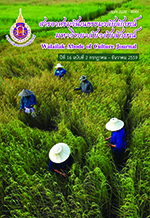แผนยุทธศาสตร์การบริหารจัดการทรัพยากรน้ำจังหวัดหนองบัวลำภู
Main Article Content
Abstract
งานวิจัยครั้งนี้เป็นการวิจัยเชิงคุณภาพ เป็นการวิจัยเชิงปฏิบัติการ (ActionResearch) มีวัตถุประสงค์ (1) เพื่อศึกษาสภาพปัจจุบันและปัญหาการบริหาร จัดการทรัพยากรน้ำของจังหวัดหนองบัวภู (2) เพื่อศึกษาแนวคิดและทฤษฎียุทธศาสตร์การบริหารจัดการทรัพยากรน้ำที่เหมาะสมกับจังหวัดหนองบัวภู (3) เพื่อจัดทำแผนยุทธศาสตร์การบริหารจัดการทรัพยากรน้ำของจังหวัดหนองบัวลำภู การศึกษาใช้วิธีการเก็บรวบรวมข้อมูลจากเอกสาร แนวคิดและทฤษฎียุทธศาสตร์การบริหารจัดการทรัพยากรน้ำ งานศึกษาวิจัยการบริหารจัดการน้ำในประเทศและต่างประเทศ ข้อมูลที่เก็บรวบรวมจัดเก็บในรูปของชั้นข้อมูลสารสนเทศ ข้อมูลจากการสัมภาษณ์เจาะลึก (In-depth Interviews) และข้อมูลจากการประชุม Focus Group
การวิเคราะห์ข้อมูลใช้การวิเคราะห์หาระดับความรุนแรงของสภาพปัญหาความต้องการใช้น้ำด้านต่าง ๆ ปริมาณน้ำต้นทุนและศักยภาพการเพิ่มน้ำต้นทุน ข้อมูลจากการสัมภาษณ์เจาะลึก (In-depth Interviews) และการประชุม Focus Group โดยเสนอผลการวิเคราะห์ในรูปของการพรรณนา บรรยาย และลงพิกัดลงในระบบสารสนเทศภูมิศาสตร์หรือ Geographic Information System (GIS) ผลการศึกษาวิจัย พบว่า
1. สภาพปัจจุบันและปัญหาการบริหารจัดการทรัพยากรน้ำของจังหวัดหนองบัวลำภู มีความขาดแคลนน้ำ ทั้งน้ำเพื่อการอุปโภคบริโภคและการเกษตรทุกปี น้ำเพื่อการเกษตรมีปริมาณการขาดแคลนมากที่สุด เนื่องจากการขาดแหล่งเก็บกักน้ำขนาดใหญ่ ปัจจุบันมีแหล่งเก็บกักน้ำความจุรวมกันทั้งหมด 20 ล้าน ลูกบาศก์เมตร/ปี ไม่เพียงพอต่อความต้องการถึง 2,400 ล้าน ลูกบาศก์เมตร/ปี ปัญหาน้ำท่วมในพื้นที่ลุ่มต่ำ ปัญหาน้ำเสียจากการใช้ปุ๋ยเคมีและยาฆ่าแมลง ปัญหาแหล่งน้ำตื้นเขิน เนื่องจากการรุกน้ำพื้นที่แหล่งน้ำและการต่อต้านการขุดลอก ปัญหาหน่วยงานด้านน้ำต่างคนต่างทำ ขาดการประสานงานเชื่อมโยงภารกิจ มีความซ้ำซ้อน สิ้นเปลืองงบประมาณ ปัญหาคณะกรรมการน้ำของจังหวัดขาดความเป็นเจ้าภาพและมีหลายคณะกรรมการ ปัญหาส่วนราชการให้ความสำคัญกับแผนพัฒนาจังหวัดน้อยกว่าแผนพัฒนาของหน่วยงาน ปัญหาข้อมูลด้านน้ำของจังหวัดอยู่กระจัดกระจาย ไม่เป็นไปในทิศทางเดียวกัน เป็นปัญหาของจังหวัดที่จะต้องมีแผนยุทธศาสตร์การบริหารจัดการทรัพยากรน้ำที่เหมาะสม และเตรียมการในอนาคตให้มีน้ำใช้อย่างเพียงพอ โดยจัดทำแผนยุทธศาสตร์การบริหารจัดการทรัพยากรน้ำของจังหวัดให้สอดคล้องกับแผนยุทธศาสตร์การบริหารจัดการทรัพยากรน้ำของชาติ ปี พ.ศ. 2558 -2569 ตามศักยภาพความเหมาะสมเชิงพื้นที่
2. แนวคิดและทฤษฎียุทธศาสตร์การบริหารจัดการทรัพยากรน้ำที่เหมาะสมกับจังหวัดหนองบัวลำภู โดยใช้แนวคิดยุทธศาสตร์การบริหารจัดการทรัพยากรน้ำของชาติ ปี พ.ศ. 2558 - 2569 นำไปจัดทำแผนยุทธศาสตร์การบริหารจัดการทรัพยากรน้ำจังหวัดหนองบัวลำภูตามศักยภาพของทรัพยากรน้ำเชิงพื้นที่ภายใต้บริบทการมีส่วนร่วมของทุกภาคส่วน
3. แผนยุทธศาสตร์การบริหารจัดการทรัพยากรน้ำของจังหวัดหนองบัวลำภู การวิเคราะห์ปัจจัยทางกายภาพและทางการบริหารจัดการ พบว่า มีการกระจายตัวของน้ำทั่วจังหวัด ที่สามารถบรรเทาปัญหาด้วยระบบแก้มลิง สถานีสูบน้ำ ฝายชะลอน้ำ การเจาะบ่อบาดาล แต่สภาพภูมิประเทศที่ไม่เอื้ออำนวยให้เก็บกักน้ำได้เพียงพอ มีดินตะกอนทับถมในแหล่งน้ำ แต่มีโอกาสนำน้ำจากเขื่อนอุบลรัตน์มาพัฒนาและการพัฒนาลุ่มน้ำลำพะเนียงร่วมกับจังหวัดเลย การจัดทำแผนยุทธศาสตร์การบริหารจัดการทรัพยากรน้ำของจังหวัดหนองบัวลำภูจะประกอบด้วย 6 ยุทธศาสตร์ ได้แก่ 1. ยุทธศาสตร์การจัดการน้ำอุปโภคบริโภค 2. ยุทธศาสตร์ด้านน้ำเพื่อการผลิต 3. ยุทธศาสตร์เพื่อการป้องกันอุทกภัย 4. ยุทธศาสตร์ด้านคุณภาพน้ำ 5. ยุทธศาสตร์ด้านอนุรักษ์และฟื้นฟูแหล่งน้ำธรรมชาติและพื้นที่ต้นน้ำ 6. ยุทธศาสตร์ด้านการบริหารจัดการ แต่ละยุทธศาสตร์จะมี 2 มาตรการคือใช้สิ่งก่อสร้าง และ ไม่ใช้สิ่งก่อสร้าง
Strategic Plan of Water Resource Management of Nongbualumpoo Province
The objectives of this study were threefold: first, to ascertain the current state of the water resource management and the management problems in the case of Nongbualumpoo Province; second, to investigate concepts and strategy theories deemed appropriate for use of the management of water resource management of the province; and third, to find ways and means to make strategic water resource management plans. The needed data were derived from a variety of documents. All of these documents were relevant to strategic concepts and theories of water resource management. Moreover, research works on water resource management both from within and without Thailand were gathered for use in the study. Above all, primary data were obtained from in-depth interviews with key informants and focus group interviews; the data from these two sources were concerned with the state of the problems, people’s needs, and views as well as recommendations concerning strategic planning for water resource management of the province.
In analyzing the collected data, the researcher made great efforts to determine the seriousness of the problems pertaining to water resource management, needs for use in various activities, the quantity of reserved water and the potentiality to increase it. Data from in-depth interviews and focus group interviews were then analyzed by dint of describing and GIS setting. It was found from the study as will be seen below:
1. On the current state of water resource management and problems relating to the water management of Nongbualumpoo Province, the following conclusions could be made: the shortage of water for consumption and agriculture was severe simply because there were no large reservoirs available. At present, all reservoirs have the capacity to contain only 20 million cubic meters per year. Thus the quantity of needed water is far from adequate; whereas additional 2,400 million cubic meters per year are required. Meanwhile, low land areas are inundated virtually every year. Polluted water caused by the use of fertilizer and insecticides for agricultural purposes was prevalent; reservoirs became shallower largely because the people kept on encroaching the water sources and resisting the digging and removing of the mud and sand from the bottom of the water sources or reservoirs, Coordinative effort among various governmental agencies in coping with the water problems were absent resulting in the waste of budget and the overlapping of the work performance of governmental agencies concerned; the provincial resource water management committee gave prominence to the governmental agencies’ development plans far greater than the provincial development plan. As a result, the nature of the water data was fragmented and was without a definite direction. In other words, each governmental agency had its own water data. For all these reasons, it is deemed highly necessary that water resource management strategy be formulated, and attempts should be made to make adequate water in the future become a reality. To achieve this end, the water resource management plan must be made and the plan should be formulated in accordance with the National Water Resource Management Strategy of 2015 - 2026.
2. On strategic concepts and theories deemed appropriate for use in the management of water resource in Nongbualampoo Province. It was cocksure that the water resource management strategy was in accordance with the National Water Resource Management Plan of 2015 – 2016. The concepts concerning the water resource management plan were based on the potentialities of water resources available in the province within the context of collaboration of all sections and people from all walks of life.
3. On making water resource management plans. Based on the analysis of the environmental factors and water resource management factors, it was found that the directions of the water flow were varied and many. This problem could be lessened by resorting to the Gamling system, water primping stations dikes and drilling wells. But the terrains were not conducive to keep a large volume of water; moreover, the mud and sand deposits were on the increasing trend. To solve the problem, efforts should be made to bring the water from Ubonrat dam for use in development together with the development of Lam Paniang where its original water source is located in Loei Province. Since Nongbualampoo Province is rich in ground water, it can be easily turned into water supply for consumption and agriculture. Now the water resource management strategy of Nongbualampoo Province has two tactics: the first tactic does not depend on construction of any kind; the second tactic requires some kind of construction. All in all, there are presently six strategies including the following: strategy of water resource management, for consumption; strategy of water resource management for industrial and agricultural production; strategy water of water management for flood prevention; strategy of water management for water quality improvement;strategy for water conservation and natural water source restoration; and finally, strategy of water resource management effectiveness.
Article Details
© 2018 by Asian Journal of Arts and Culture, Walailak University. All rights reserved.


